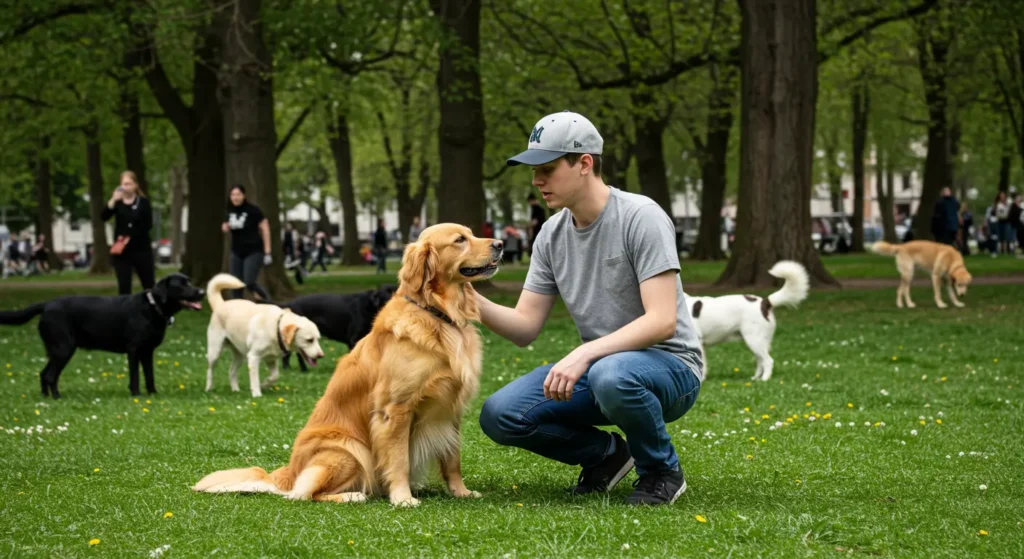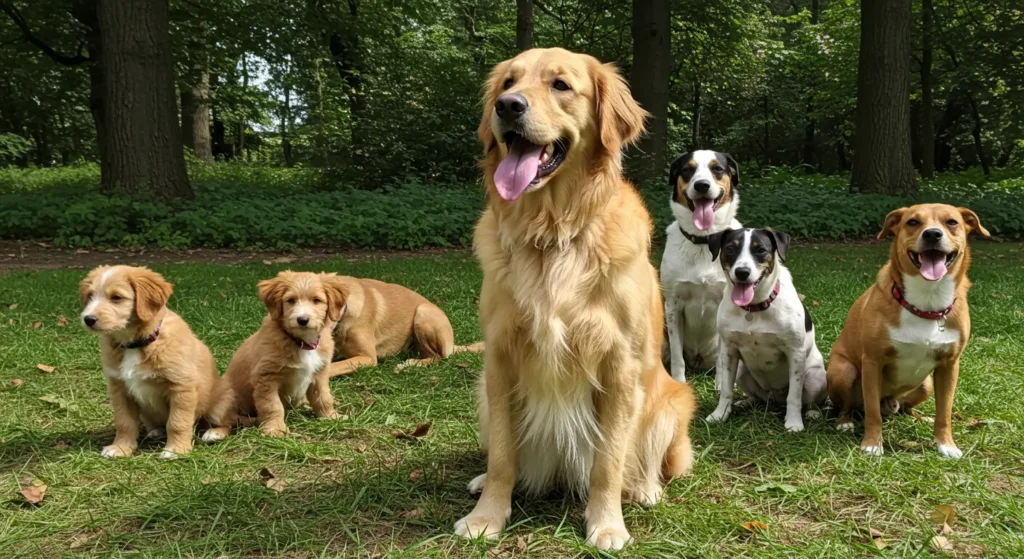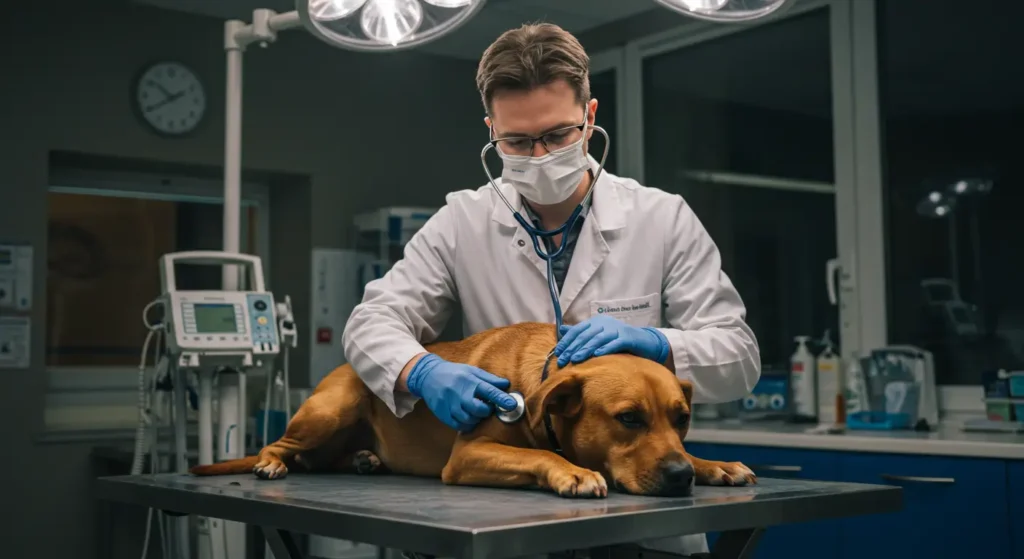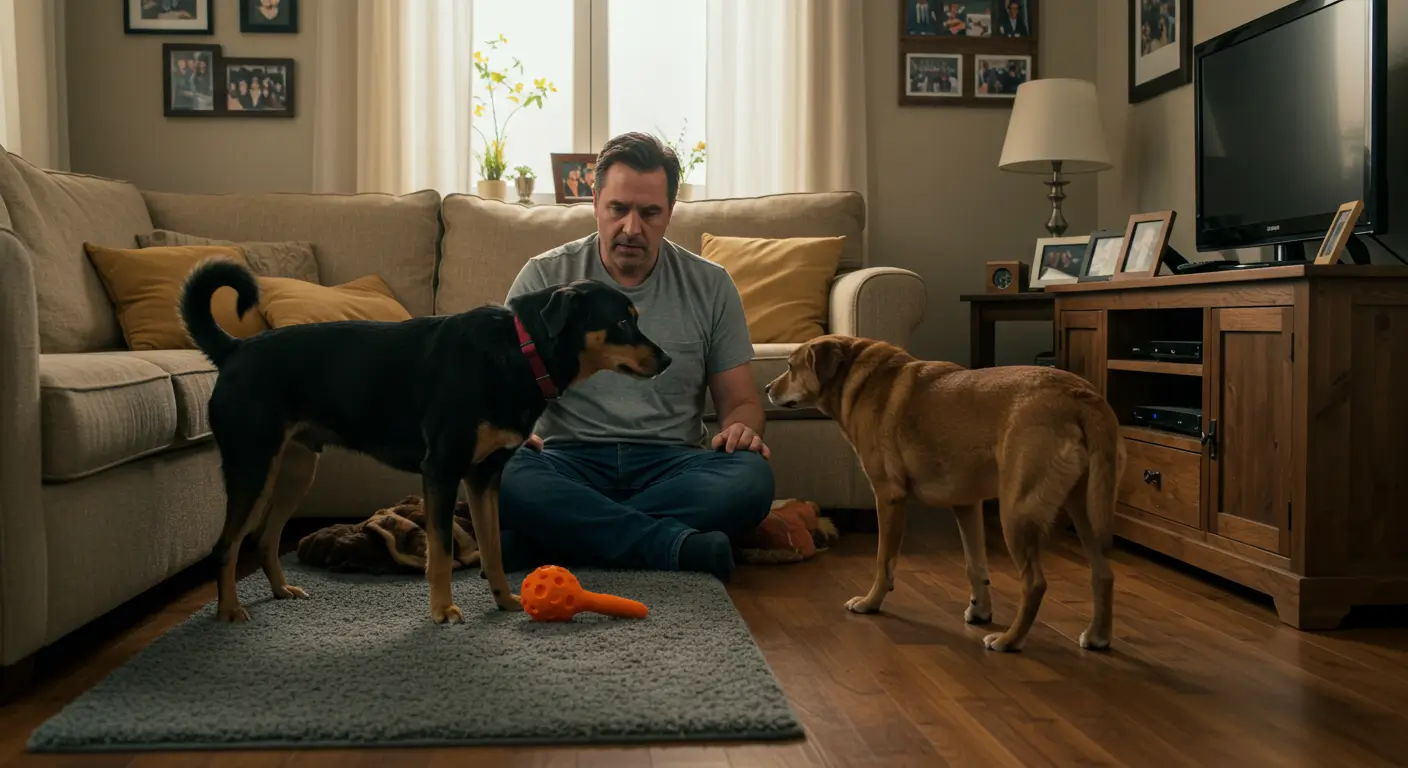As a dog owner, you want the best for your pet. This includes their health and well-being. Recognizing when your dog needs to be neutered is key. Neutering can greatly impact your dog’s behavior and health.
It can reduce health risks and unwanted behaviors. Knowing the signs your dog needs to be neutered helps you make the right choice for their care.
Table of Contents
Neutering can lower testicular cancer risk in male dogs by up to 99%. It also cuts urine marking by 50%. It’s important to watch for signs like aggression or roaming. This helps decide if neutering is right for your pet.
With 3.9 million pets in shelters yearly in the U.S., neutering is crucial. It helps control pet overpopulation.
Recognizing neutering signs can prevent unwanted litters and health issues. It also reduces aggression and prostate problems in males. As a responsible owner, knowing the benefits of neutering is vital. It ensures your pet gets the best care.
Understanding Neutering and Its Benefits
As a dog owner, it’s crucial to know when to neuter your dog. This helps prevent unwanted breeding and lowers health risks. Neutering can greatly benefit your dog’s health and behavior.
Neutering removes the risk of testicular cancer and lowers the chance of prostate and perianal tumors. It also stops unwanted breeding. This helps control the pet population and reduces dog euthanasia.
What is Neutering?
Neutering, or orchiectomy, is a common vet procedure. It involves removing a male dog’s testicles. This surgery prevents breeding and reduces health risks.
Health Benefits for Male Dogs
Neutering offers many health benefits for male dogs, including:
- Elimination of the risk of testicular cancer
- Reduction of the risk of prostate diseases and perianal tumors
- Prevention of unwanted breeding
Behavioral Improvements
Neutering also improves a dog’s behavior. It reduces aggression and roaming. Intact male dogs often show dominant behavior and mark their territory. Neutering prevents these issues.
Signs of Behavioral Changes in Unneutered Dogs
As a dog owner, you might see changes in your dog’s behavior if it’s not neutered. Early neutering signs in dogs include more aggression or dominance, marking territory, and too much barking or howling. These signs are often linked to dog behavior before neutering, caused by hormonal changes.
Increased Aggression or Dominance
Unneutered dogs may show aggressive behavior like growling or lunging. This is because of high testosterone levels. It can cause fights with other dogs or even people.
Marking Territory
Unneutered dogs often mark their territory with urine. This is a sign of early neutering signs in dogs. It’s driven by hormones, especially testosterone.
Excessive Barking or Howling
Unneutered dogs might bark or howl too much. This is a sign of dog behavior before neutering. It’s often due to sexual frustration or hormonal changes.
By noticing these signs of behavioral changes in unneutered dogs, you can take action. Neutering can help reduce bad behaviors and make your dog happier.
The Role of Hormones in Dog Behavior
As a dog owner, you might have seen changes in your dog’s behavior, especially during puberty. Hormones, especially testosterone, greatly influence dog behavior. Knowing about testosterone levels and their effects on your dog’s behavior is key. For example, male dog neutering signs include aggression, marking territory, and roaming. On the other hand, female dog spaying signs might be heat cycles and breeding behaviors.
Hormone surges during puberty can change dog behavior, usually between 6 months to 2 years old. It’s vital to watch your dog’s behavior and talk to your vet about the best time for neutering or spaying. Some important things to remember include:
- Hormonal changes can lead to behavioral changes, such as increased aggression or dominance.
- Neutering or spaying can reduce unwanted behaviors, such as breeding attempts and urine marking.
- Testosterone levels drop to almost nothing within a month after neutering a male dog.
It’s also worth noting that female dog spaying signs can vary. Some female dogs may become aggressive after neutering due to prenatal testosterone exposure. But, with the right care and attention, your dog can live a happy and healthy life. By understanding hormones’ role in dog behavior, you can make better decisions for your dog’s health and happiness.
Changes in Social Interactions
As a dog owner, you might see changes in how your dog interacts with others. These changes can be small but affect your dog’s behavior and health a lot. One common change is trouble with other pets, leading to fights.
Another sign is when your dog acts bossy over other dogs or people. This could mean they have hormonal issues that neutering can fix. Also, unneutered dogs might wander off looking for a mate. This can be dangerous for them.

- Increased aggression or dominance
- Mounting behaviors
- Straying from home
Seeing these changes means your dog might need to be neutered. Neutering can help lower aggression, bossy behavior, and wandering off. Recognizing these signs helps you take care of your dog’s health.
It’s key to notice these social changes, as they often point to hormonal issues. Neutering can help prevent these problems and make your dog happier and healthier. Talk to your vet to figure out the best plan for your dog.
Health Issues to Watch For
As a dog owner, knowing about health issues is key. This is especially true when thinking about when to neuter a dog. Neutering symptoms in dogs can be a big worry. Knowing about these issues helps you make a smart choice.
One major health worry is testicular cancer. Neutering can stop up to 90% of cases, says the National Institutes of Health (NIH). Other health problems include prostate issues like Benign Prostatic Hyperplasia (BPH). This can cause the prostate to grow and is common in dogs over 5.
Unneutered male dogs face a higher risk of these problems. Neutering can greatly lower this risk. It also helps stop dogs from wandering off, which can prevent accidents and injuries.
Thinking about the health benefits of neutering is important. Knowing the risks of not neutering helps you choose what’s best for your dog. Key points to remember include:
- Neutering can reduce the risk of testicular cancer and prostate problems
- Neutering can decrease roaming tendencies and reduce the risk of accidents and injuries
- Neutering can help control pet overpopulation by preventing unwanted pregnancies
By weighing these points, you can choose what’s best for your dog’s health. Always talk to your vet about when to neuter. The right age can depend on your dog’s breed and size.
| Health Issue | Risk Reduction |
|---|---|
| Testicular Cancer | Up to 90% |
| Prostate Problems | Significant reduction |
| Roaming Tendencies | Decreased risk of accidents and injuries |
Frequency of Heat Cycles in Female Dogs
As a dog owner, knowing about heat cycles in female dogs is key. This is especially true when looking at early neutering signs in dogs. Female dogs usually have two heat cycles a year, about every 6 months. But, this can change based on the dog’s breed and size.
The first heat cycle often starts at 6 months old. But, smaller dogs might start as young as 4 months. Larger dogs might wait until they are 18 to 24 months old. Knowing dog behavior before neutering helps decide the best time for neutering.
Heat Cycle Stages
The heat cycle has four stages: Proestrus, Estrus, Diestrus, and Anestrus. Each stage has its own signs. Knowing these stages helps spot early neutering signs in dogs.
- Proestrus: lasts between 7 to 10 days
- Estrus: lasts 5 to 10 days, during which bleeding may reduce or stop
- Diestrus: can last anywhere from 10 to 140 days
- Anestrus: typically lasts around 6 months before the next heat cycle begins
As female dogs get older, their heat cycles might happen less often. But, they will still have heat cycles throughout their lives. Knowing about heat cycles and dog behavior before neutering helps make good choices for your dog’s health.
The Impact of Neutering on Lifespan
Neutering can greatly affect a dog’s lifespan. Studies show that neutered dogs live longer than those that aren’t. This is because neutering removes the risk of testicular cancer, a common issue in intact males. It also may lower the risk of other health problems like benign prostatic hyperplasia and prostatitis.
Some key benefits of neutering on a dog’s lifespan include:
- Reduced risk of certain cancers, such as testicular cancer and uterine cancer
- Lower risk of benign prostatic hyperplasia and prostatitis
- Decreased risk of roaming behaviors that can lead to unwanted pregnancies and injuries
When deciding to neuter your dog, it’s important to look at male dog neutering signs and female dog spaying signs. Neutering can help with behavioral issues like aggression and excessive barking. But, it’s key to talk to a vet to see what’s best for your dog.
Statistics show that neutered male dogs live about 18% longer than intact males. Spayed females live about 23% longer than intact females. Thinking about how neutering affects a dog’s lifespan and health can help you make a good choice for your pet.
Timing: When is the Best Age to Neuter?
When thinking about signs your dog needs to be neutered, timing is key. The right age to neuter a dog varies based on breed, size, and health. For instance, smaller dogs can be neutered earlier, while bigger dogs might need to wait longer.
Important things to think about when choosing the best age for neutering include:
- Breed: Each breed has its own neutering age recommendation.
- Size: Bigger dogs often need to wait longer before being neutered.
- Health status: Dogs with health problems might need a different neutering schedule.
Vets usually suggest neutering male dogs around six months old. But, larger breeds might need to wait until they’re 1-2 years old. Dog neutering signs like aggression or marking territory can mean it’s time to neuter. Knowing what affects the best neutering age helps you make a smart choice for your dog’s health.

Talking to your vet is crucial to find the best neutering age for your dog. They can give advice tailored to your dog’s needs and situation.
| Breed | Recommended Neutering Age |
|---|---|
| Small breeds | 6 months |
| Medium breeds | 9-12 months |
| Large breeds | 1-2 years |
Myths and Misconceptions About Neutering
When thinking about when to neuter a dog, many owners face myths and misconceptions. It’s key to know the facts from fiction to make a smart choice. A common myth is that neutering changes a dog’s personality. But, this isn’t always true. While neutering symptoms in dogs might include less aggression or dominance, the dog’s core personality stays the same.
Another myth is that neutering is expensive and complicated. But, many animal welfare groups and vet clinics offer cheap and safe neutering options. In fact, neutering costs much less than raising a litter of puppies.
Some important points to think about when looking at neutering myths include:
- Neutering can lower the risk of health issues like testicular cancer and prostate problems.
- It can also cut down on unwanted behaviors like marking territory and too much barking.
- The best time for neutering varies based on the dog’s breed, size, health, and behavior.
In conclusion, talking to a vet is crucial to figure out the best neutering plan for your dog. It helps to know the truth about when to neuter a dog and neutering symptoms in dogs.
| Myth | Fact |
|---|---|
| Neutering will change a dog’s personality | Neutering may reduce aggression or dominance, but the core personality remains intact |
| Neutering is a costly and complicated procedure | Many animal welfare organizations and veterinary clinics offer affordable and safe neutering services |
The Process of Neutering Your Dog
Understanding the neutering process is key when considering it for your dog. Neutering is a surgery that removes a male dog’s testicles while they are under general anesthesia. This helps prevent early neutering signs in dogs, like aggression and marking territory, by lowering testosterone levels.
Your vet will talk about the benefits and risks of neutering before the surgery. They’ll also explain how to prepare your dog and what to expect during recovery.
After the surgery, it’s important to follow your vet’s aftercare instructions. This includes:
- Providing a quiet and comfortable space for your dog to recover
- Monitoring for signs of complications, such as bleeding or swelling
- Preventing your dog from licking or chewing at the incision site

By understanding the neutering process and following your vet’s advice, you can help your dog recover smoothly and successfully.
Making the Decision to Neuter
Deciding to neuter your dog is a big choice. It’s important to talk to your vet first. They can help you understand what’s best for your dog.
Think about your dog’s specific needs. Things like breed, age, and behavior matter. Knowing these helps you make a choice that’s good for them.
Consider the good things about neutering, like less aggression and fewer health issues. But also think about any possible downsides.
In the end, choosing to neuter is up to you. But with your vet’s advice and knowing the facts, you can pick the best option for your dog.
FAQ
What are the signs that my dog needs to be neutered?
Signs your dog might need neutering include aggression, marking territory, and howling. They might also have trouble with other pets and wander off more.
What are the health benefits of neutering a dog?
Neutering can help prevent testicular cancer and prostate issues in males. It also makes dogs live longer and feel better overall.
How often do female dogs go through heat cycles?
Female dogs go through heat cycles every 6 to 12 months. They may act differently, like being more affectionate or restless, and attract male dogs.
What is the best age to neuter a dog?
The best time to neuter a dog varies by breed and size. Vets usually suggest neutering between 6 to 12 months. Talk to your vet for the best time for your dog.
What are some myths and misconceptions about dog neutering?
Some myths say neutering makes dogs gain weight, change personality, or is not needed. Always talk to your vet to learn the truth about neutering.
What can I expect during the neutering process and recovery?
During neutering, your dog will be asleep, and the vet will remove their reproductive parts. After, they might need pain meds, rest, and watching for any issues. Your vet will tell you how to care for your dog after surgery.
How do I decide if I should neuter my dog?
Decide with your vet’s help. They can guide you on the benefits, when to do it, and special considerations for your dog’s breed. Think about your dog’s needs before making a choice.

